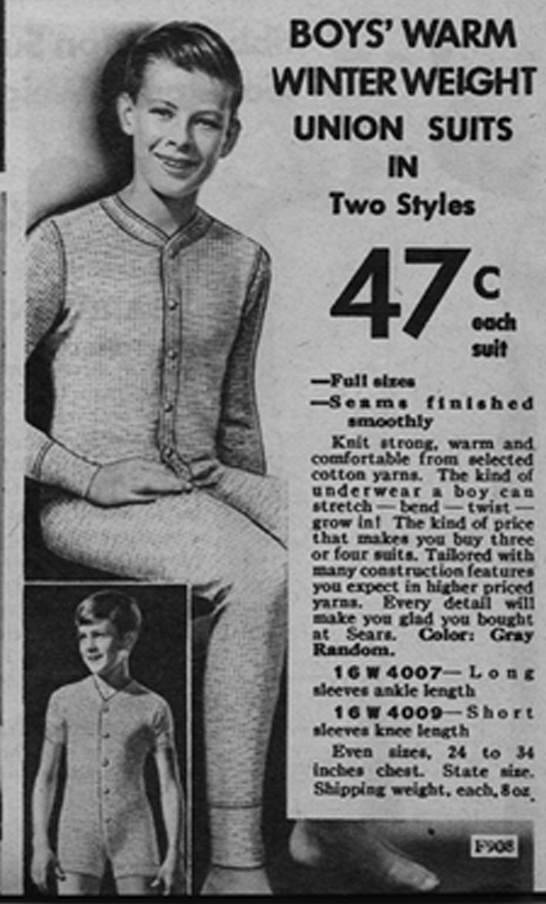
American Mail Order Catalogs: Underwear (1935)

Figure 1.-- Here are boys' winter union suits from the Sears Fall and Winter catalogue, 1935 (p F. 908). These cotton suits are heavy "winter weight" quality and are sold in two styles, (1) with long sleeves and long legs, and (2) with short sleeves and "knee length" (although the image in the inset shows that they are really trunk length union suits, ending high on the thigh. They are sold by chest sizes from 24 to 34, which would fit boys from
about 11 to 17.
|
|
We do not have much information on underwear in 1935 yet. We have collected a few items. The VestPants combinations I do not think were very common. Garter waists had been commonly worn by American children for several decades. As long stockings had begun to declined in popularity, we begin to see garter waists becoming less common. Here both the increasing popularity of socks and long pants were factors. We see children's underwear that include some more modern-looking styles. Biut we still see youngers children's underwear done in styles both boys and girls wore. We also still see union suits.
This advertisement for boys' waist suits came from Ward's Fall and Winter catalog for 1935-36 (p. 155). In many of the mail order catalogs waist suits are shown as being equally appropriate for boys and girls from about age 2 to age 12 or 13. Here, interestingly, the waist suits for boys are separated from those for girls although the design of the two is not strikingly different. These waist suits are heavy weight union suits for winter wear, but they have reinforced shoulder straps to support button-on short pants or knickers and metal pinning tubes so that supporters for long stockings can be fastened on. They are available in both short and long sleeve models for boys between the ages of 2 and 12. All the models shown here have ankle-length legs.
We are not familiar with Lane Bryant. We have new other entries from this mail-order company. Here we see the transition from pre elastic stitching to elastic knit stretch materials we probably take for granted. The shirts did not have enough stretch to have band necks to go over one's head so buttons were necessary to accommodate the head. These buttons then had to be rebuttoned once worn which was more work. Even more was the fact that drawers or pants, bloomers or panties all had to be buttoned to something to stay up. This presented several inconveniences. First, a garment was needed to hold up one's under pants. That may explain why very young children only had shirts. Infants in the US and children up to 8 in France and maybe some other countries. Second, for young children this meant that someone older had to help with buttons for getting dressed and using the bathroom. It must have been much more common for older children maybe five, six or even an eight year old to require help to use the bathroom.
Sears Winter Union Suits
Here are boys' winter union suits from the Sears Fall and Winter catalogue, 1935 (p F. 908). These cotton suits are heavy "winter weight" quality and are sold in two styles, (1) with long sleeves and long legs, and (2) with short sleeves and "knee length" (although the image in the inset shows that they are really trunk length union suits, ending high on the thigh). They are sold by chest sizes from 24 to 34, which would fit boys from about 11 to 17. These are not waist union suits and therefore have no extra buttons around the waist or tabs at the sides for hose supporters, although some boys might wear an additional garter waist (particularly with the short leg style) if they had to wear long stockings. The color is random gray--a popular variegated color for men's and boys' union suits because they showed soil less readily and had a very rugged, masculine appearance. The ad does not tell us what kind of seat these suits have. The most common arrangement for boys' union suits was drop seats (a kind of trap door in the back secured to the suit by three buttons), but for older boys, the newer flap-seat featured on men's union suits was often provided (a verticle opening in the rear with overlapping sides that fastened with a single of double button). The boys in the illustrations look about 12 and 14.
The ad copoy text read, :"Boys' Warm Winter Weight Union Suits in Two Styles, 47 cents each
suit. Full sizes. Seams finished smoothly. Knit strong, warm and
comfortable from selected cotton yarns. The kind of underwear a boy
can stretch--bend--twist--grow in! The kind of price that makes you
buy three or four suits. Tailored with many construction features you
expect in higher priced yarns. Every detail will make you glad you
bought at Sears. Color: Gray Random.
16W4007--Long sleeves, ankle length.
16W4009--Short sleeves, knee length
Even sizes, 24 to 34 inches chest. State size. Shipping weight, each,
8 ounces."
HBC

Navigate the Boys' Historical Clothing catalog/magazine pages:
[Return to the Main American mail order 1935 page]
[Main photo/publishing page]
[Store catalogs]
[Fashion magazines]
Navigate the Boys' Historical Clothing Web Site:
[Introduction]
[Activities]
[Biographies]
[Chronology]
[Clothing styles]
[Countries]
[Bibliographies]
[Contributions]
[FAQs]
[Glossary]
[Images]
[Links]
[Registration]
[Tools]
[Boys' Clothing Home]
Navigate the Boys' Historical Clothing Web Site:
[Sailor hats]
[Flat caps]
[Sailor suits]
[Buster Brown suits]
[Eton suits]
[Rompers]
[Tunics]
[Smocks]
[Pinafores]
[Knickers]
[Long stockings]
[Knee socks]
[Underwear]
Created: 2:44 AM 1/24/2011
Last updated: 6:54 AM 1/25/2011



